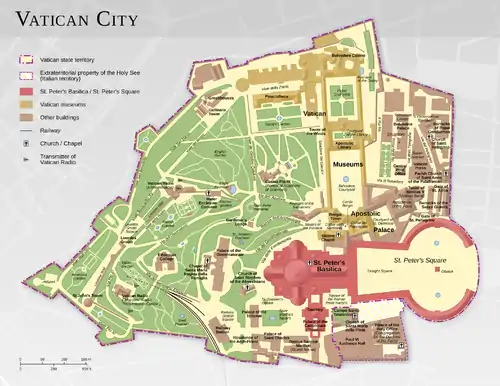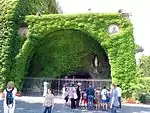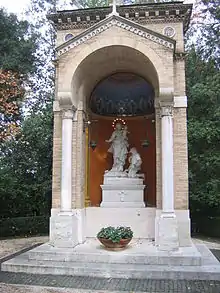Gardens of Vatican City
The Gardens of Vatican City (Latin: Horti Civitatis Vaticanae), also informally known as the Vatican Gardens (Italian: Giardini Vaticani) in Vatican City, are private urban gardens and parks which cover more than half of the country, located in the west of the territory and owned by the Pope. There are some buildings, such as Vatican Radio and the Governor's Palace, within the gardens.
| Gardens of Vatican City | |
|---|---|
 The Vatican Gardens | |
 | |
| Type | Botanical |
| Location | |
| Coordinates | 41°54.2′N 12°27.2′E |
| Area | 23 hectares (57 acres) |
| Owned by | The Pope as Bishop of Rome |
| Status | Active |
The gardens cover approximately 23 hectares (57 acres), about half of the city. The highest point is 60 metres (197 ft) above mean sea level. Stone walls bound the area in the North, South, and West. The gardens and parks were established during the Renaissance and Baroque era and are decorated with fountains and sculptures.
Pope Francis opened the Vatican Gardens to the public in 2014.[1] Individuals and pre-formed groups, considered to consist of 16 or more people, may visit the Gardens with the presence of a tour guide.[2] The gardens also enshrine 17 Marian images venerated worldwide at the designation of the Pope, who is the owner of the gardens.
History
.jpg.webp)
Pious tradition claim that the foundation site of the Vatican Gardens was spread with sacred soil brought from Mount Calvary by Empress Saint Helena[3][4] to symbolically unite the blood of Jesus Christ with that shed by thousands of early Christians, who died in the persecutions of Emperor Nero Caesar Augustus.[3]
The gardens date back to medieval times when orchards and vineyards extended to the north of the Papal Apostolic Palace.[5] In 1279, Pope Nicholas III (Giovanni Gaetano Orsini, 1277–1280) moved his residence back to the Vatican from the Lateran Palace and enclosed this area with walls.[6] He planted an orchard (pomerium), a lawn (pratellum), and a garden (viridarium).[6] Firstly, they appeared near the hills of Sant'Egidio where today the Palazzetto del Belvedere and the Courtyards of the Vatican Museums are located.
_-_stained_glass%252C_Saint_Th%C3%A9r%C3%A8se_of_Lisieux%252C_detail.jpg.webp)
The site received a major re-landscaping at the beginning of the 16th century,[5] during the pontificate of Pope Julius II.[7] Donato Bramante's original design was then split into three new courtyards,[7] the Cortili del Belvedere, the "della Biblioteca" and the "della Pigna" (or Pine Cone)[5][7] in the Renaissance landscape design style. Also in Renaissance style, a great rectangular Labyrinth, formal in design, set in boxwood and framed with Italian stone pines, (Pinus pinea) and cedars of Lebanon, (Cedrus libani).[3] In place of Nicholas III's enclosure, Bramante built a great rectilinear defensive wall.[7]
In 1921 a fire broke out inside the sanctuary of the Basilica of Loreto and destroyed a statue of the Virgin Mary, known as Our Lady of Loreto. The statue was commissioned by Pope Pius XI in 1922. It was carved from cedars of Lebanon from the Vatican Gardens. The sculpture, designed by Enrico Quattrini and painted by Leopoldo Celani, is still one of the most venerated today in the Basilica of Loreto, in the Marche region.
Since the end of 2014, the Vatican Museums and the Directorate of Technical Services of the Governorate of Vatican City State have been running the project of restoration and conservation[8] of various stone artifacts in the gardens. The goal of the project has been to prevent the deterioration of the objects of art-historical interest.
In October 2017 the professionals involved in the restoration conducted a study to consider, from a scientific point of view, modern methods and eco-sustainable techniques in application to the conservation of the artifacts over time. After a careful study, they opted for non-toxic and environmentally friendly products, such as oregano (Origanum vulgare) and thyme (Thymus vulgaris), along with other plant protection products used individually or combined.[9]
Today's Vatican Gardens are spread over nearly 23 hectares (57 acres), they contain a variety of medieval fortifications, buildings and monuments from the 9th century to the present day, set among vibrant flower beds and topiary, green lawns and a 3 hectares (7 acres) patch of forest. There are a variety of fountains cooling the gardens, sculptures, an artificial grotto devoted to Our Lady of Lourdes, and an Olive tree donated by the government of Israel.[10]
Both the Vatican and Castel Gandalfo gardens became open to the general public in 2014.[11]
Patroness of the Gardens
Pope Pius XI designated Saint Therese of Lisieux The Little Flower as the official Patroness of the gardens on May 17, 1927, according to her the title as "Sacred Keeper of the Gardens" and within the same year, a small chapel dedicated to her was built within the gardens near the Leonine walls.
List of Marian images enshrined
The following are venerated images of the Blessed Virgin Mary enshrined at the Vatican Gardens:
| Image within the Gardens | Place of Devotion | Nation | Year of Devotion | Date of Installation | Feast Day |
|---|---|---|---|---|---|
| Lourdes, France | 1858 | 1 June 1902 | February 11 | ||
| Monte Figogna | 1490 | 2 May 1917 | August 29 | ||
| Tepeyac, Mexico | 1531 | 14 October 1939 | December 12 | ||
| Our Lady of Fátima | Fátima, Portugal | 1917 | 29 May 1983 | 13 May | |
| The Madonna of Schoenstatt | Vallendar, Germany | 1914 | 1992 | October 18 | |
| The Black Madonna of Częstochowa | Jasna Góra, Poland | 1382 | 1994 | August 26 | |
| The Virgin of Mercy | Savona | 1536 | 10 May 1995 | March 18 | |
| Our Lady of Divine Love | Via Ardeatina | 1740 | 10 May 1999 | Monday of Pentecost | |
| Our Lady of Sacred Heart of Taggia | Rome | 1855 | 21 March 2006 | March 11 | |
| Our Lady of Good Counsel | Genazzano, Italy | 1467 | 11 July 2009 | April 26 | |
| Virgin of Suyapa | Honduras | 1747 | 20 September 2013 | February 3 | |
| Nuestra Senora de La Antigua | Panama | 1513 | 26 October 2013 | September 9 | |
| Our Lady of Charity | Cuba | 1612 | 28 August 2014 | September 8 | |
| Our Lady of Penafrancia | Philippines | 1434 | 3 December 2015 | 3rd Saturday in September | |
| Our Lady of Aparecida | Brazil | 1717 | 3 September 2016 | October 12 | |
| Virgen de Copacabana | Bolivia | 1583 | 25 September 2017 | February 2 August 5 | |
| Virgin of Presentation of El Quinche | Ecuador | 1580 | 17 May 2019 | February 2 |
Gallery
 Part of the Vatican Gardens
Part of the Vatican Gardens The Fountain of the Eagle "Fontana dell'Aquilone" in the Vatican Gardens
The Fountain of the Eagle "Fontana dell'Aquilone" in the Vatican Gardens Armenian cross monument (Khatchkar) inside the Vatican Gardens
Armenian cross monument (Khatchkar) inside the Vatican Gardens Vatican Gardens
Vatican Gardens Palace of the Governorate of Vatican City State
Palace of the Governorate of Vatican City State Vatican Gardens
Vatican Gardens
References
Notes
- https://www.romewise.com/vatican-gardens.html
- "Guided tour of the Vatican Gardens for individuals and groups". vatican.va.
- "MO Plants: Vatican Gardens". copyright 2006 MoPlants.com]. Archived from the original on March 8, 2012. Archived: March 8, 2012.
- Patron saint of archaeologists
- "Al Pellegrino Cattolico: The Vatican Gardens". copyright 2008 Al Pellegrino Cattolico s.r.l. Via di Porta Angelica 81 (S.Pietro) I- 00193 Roma, Italy. Archived from the original on April 13, 2008. Retrieved November 21, 2008.
- "Official Vatican City State Website: A Visit to the Vatican Gardens". copyright 2007–08 Uffici di Presidenza S.C.V. Archived from the original on August 21, 2008. Retrieved November 21, 2008.
- "Vatican Gardens". copyright 2008 Cooperativa IL SOGNO, Viale Regina Margherita, 192 – 00198 ROMA. Retrieved November 21, 2008.
- "The restoration of the works of the Vatican Gardens". www.museivaticani.va. Retrieved November 25, 2019.
- Rizzi, Cinzia (October 4, 2017). "Il lifting ecosostenibile dei Giardini Vaticani". euronews (in Italian). Retrieved November 25, 2019.
- Hofmann, Paul (July 6, 1997). "Glorious Gardens of the Vatican". The New York Times. Retrieved March 1, 2013.
- https://www.pope2you.net/are-vatican-gardens-worth-visiting/
Bibliography
- Nichols, Fiona (August 1, 2006). Rome and the Vatican. New Holland Publishers. pp. 85–. ISBN 978-1-84537-500-3. Retrieved March 4, 2010.
- Ricci, Corrado. "Vatican: Its History Its Treasures" Contributor Ernesto Begni. copyright 2003 Published by Kessinger Publishing, ISBN 0-7661-3941-7, ISBN 978-0-7661-3941-1
 This article incorporates text from a publication now in the public domain: Herbermann, Charles, ed. (1913). "Vatican City Gardens". Catholic Encyclopedia. New York: Robert Appleton Company.
This article incorporates text from a publication now in the public domain: Herbermann, Charles, ed. (1913). "Vatican City Gardens". Catholic Encyclopedia. New York: Robert Appleton Company.
Sources
The initial version is based upon the article it:Giardini Vaticani of the Italian language edition of Wikipedia. Data concerning the measures of lengths were taken from the article de:Vatikanische Gärten of the German language edition of Wikipedia.
External links
| Wikimedia Commons has media related to Giardini Vaticani. |
- current and historical layouts
- Official website
- The Vatican: spirit and art of Christian Rome, a book from The Metropolitan Museum of Art Libraries (fully available online as PDF), which contains material on the gardens (pp. 155–164)



